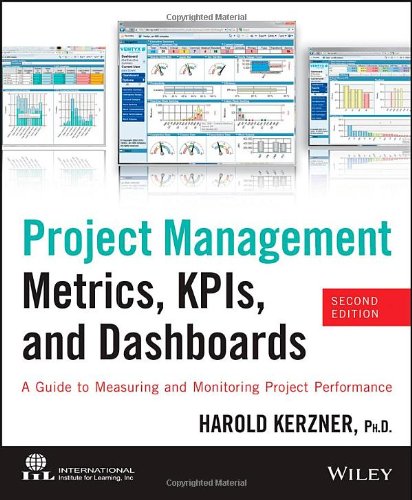Project Management Metrics, KPIs, and Dashboards: A Guide to Measuring and Monitoring Project Performance

- Used Book in Good Condition
The new edition of Harold Kerzner’s bestselling book on measuring project management performance With today’s complex projects, increased stakeholder involvement, and advances in computer technology, metrics and key performance indicators (KPIs) have become increasingly integral to informed decision-making and effective project management. Project Management Metrics, KPIs, and Dashboards, Second Edition helps functional managers gain a thorough grasp of what metrics and KPIs are and how to use them, as well as an understanding of different dashboard types, design issues, and applications. Closely aligned with PMI®’s PMBOK® Guide, this new edition features: New content on topics ranging from customer relations management and project oversight to agile and SCRUM metrics, as well as metrics, pitfalls, and myths An emphasis on value, including an in-depth discussion of value-driven metrics and value-driven KPIs Full-color screen shots showing dashboards from some of the most successful
More
 Effective Project Management: Traditional, Agile, Extreme
Effective Project Management: Traditional, Agile, ExtremeThe popular guide to the project management body of knowledge, now fully updated Now in its seventh edition, this comprehensive gu…
 Agile Project Management QuickStart Guide: A Simplified Beginners Guide To Agile Project Management
Agile Project Management QuickStart Guide: A Simplified Beginners Guide To Agile Project ManagementAgile Project Management, Made SimpleOver the last decade and a half, Agile Project Management has surged in popularity across the…


An essential read for PMO influencers, a good read for any professional project manager,
BACKGROUND: I am professional project manager, and am working towards getting a masters degree in project management.
WHAT I LIKE:
– Visually, this is an enticing book where graphs and headings use color
– Dr. Kerzner provides glimpses into how things work in other organizations. On page 27, he explains how Disney used six constraints, three more besides the familiar time, scope and cost (they were, safety, aesthetic value and quality). This introductory chapter nicely explains how project success can be variously defined depending on the project objectives. Page 195 has a terrific graphic showing the triple constraint surrounding the constraints of image/reptuation, risk, quality and value (with explanatory text surrounding it).
– Dr. Kerzner offers his advice on useful / not useful metrics to gather. On page 57, for example, he points out that tracking scope creep can be questionable because of the many causes for scope creep. Throughout the book, he offers similar tips highlighted in light blue boxes that are easily identified.
– In chapter three, Dr. Kerzner gives some history on early project metrics, and how metrics are used on today’s projects. The whole chapter eases the reader into understanding metric management and characteritics of a metric.
WHO THIS BOOKS IS FOR: As I went through this book, I thought that the reason I’m only able to give it 4-stars instead of 5-stars is because I’m not working in a role with influence over how our PMO operates. This book is best read by PMO directors and others who exert control over their PMOs and how projects are actively managed within the organization.
CONCLUSION: An essential read for project management influencers, a good read for any project manager.
Was this review helpful to you?

|Useful info for the new PM,
The first few chapters of the book was similar to the material presented in the Project Management Institute’s PMBOK, however, Kerzner does a much better job describing the material than the PMBOK.
In section 3.9, Dr. Kerzner defines his categories of metrics, none of which focus on a product (a.k.a. scope). In the iron triangle of project management, a PM is to make decisions trading off on cost, schedule, and scope. If a PM isn’t tracking how well a product is meetings its performance specifications, how can he/she be expected to make trade-offs while managing the project?
I was really hoping the book would contain ideas on metrics for managing software projects, and was sorely disappointed at the omission. I was surprised then to see a metric for Agile and Scrum, which is an offshoot of software project management. The metric presented is only one of the relevant metrics that could be collected on Agile projects. But that could be because the the book sources Wikipedia for the quote, instead of using any material from the Scrum Alliance, the authoritative source on Scrum methodologies.
The discussion in Chapter 7 illustrates examples of dashboards that are commercially available from Ventyx, Inc.; Computer Associates, Inc.; PieMatrix; and Dr. Kerzner’s own International Institute of Learning. These are great examples of the products that are available and what they have to offer project managers.
There is much good information for newcomers to project management and metrics management. This book may be useful to that group of readers.
Was this review helpful to you?

|